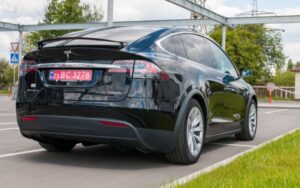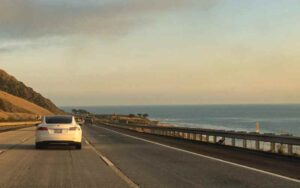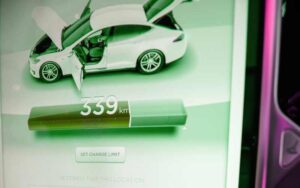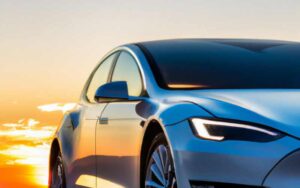What Software Does Tesla Use For Autopilot? (Explained)
Last updated on September 12th, 2023 at 03:05 am
Technology is rapidly transforming the way we interact with our vehicles.
With the help of technology, many brands are now pushing the boundaries of what’s possible with electric vehicles and autonomous driving technology.
One company at the forefront of this revolution is Tesla, with its advanced Autopilot system that allows cars to steer, accelerate, and brake automatically.
If you have ever wondered what software powers this futuristic technology, you are not alone. I’ll be satisfying your curiosity in this piece.
Full Self Driving (FSD) is the software that Tesla uses for Autopilot. This software works with the hardware, such as cameras, sensors, and radar, for the Autopilot’s operation. The FSD software handles complex calculations involving advanced algorithms, machine learning, etc., to interpret and analyze the data gathered by the cameras and sensors.
In this article, I will delve into the world of Tesla’s Autopilot and explore the software behind its innovative self-driving capabilities.
I’ll also reveal the operating system that Tesla Autopilot uses. After reading this article, you will discover everything you need to know about Tesla Autopilot.
What Software System Does Tesla’s Autopilot Use?
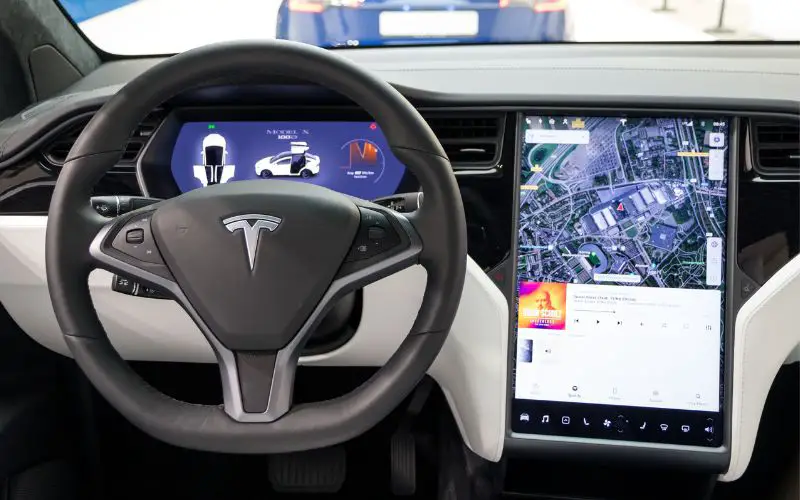
Full Self-Driving software is the software that Tesla’s Autopilot uses, which encompasses the overall system that enables autonomous driving features.
The FSD software’s features include auto steer, auto park, Autopilot navigation, traffic-aware cruise control, and automatic lane changes.
It also includes the ability to summon the vehicle from its parking lot.
Tesla’s Autopilot uses a combination of hardware and software to power its Autopilot system.
The hardware includes cameras, radar sensors, ultrasonic sensors, and a powerful onboard computer, which collects data and provides real-time feedback to the vehicle’s control system.
Tesla’s Autopilot software is built on a Linux-based operating system and includes various custom-built software components.
The components include a neural network for image recognition, a decision-making system for controlling the vehicle, and a mapping system for navigation.
The software of the Autopilot system consists of machine learning algorithms, computer vision algorithms, and advanced signal processing techniques.
The combination of the software mentioned processes the data collected from the hardware sensors to create a virtual image of the vehicle’s surroundings.
The automobile, therefore, uses the virtual image created by the software to analyze and predict the behavior of other vehicles on the road, as well as detect lane markings and traffic signs.
In addition, the Autopilot system also incorporates a few safety features such as forward collision warning, automatic emergency braking, and lane departure warning.
These features help prevent accidents and keep drivers and passengers safe.
Check out the table below for the pros and cons of Tesla’s Autopilot feature.
| Pros | Cons |
|---|---|
| Enhanced driving experience. | It is limited to specific driving scenarios. |
| Frequent software updates. | Vulnerable to hacking and misuse. |
| Access to improved safety features. | Potential for system errors. |
| Adaptive cruise control traffic-aware navigation. | The vehicle with autopilots is costly. |
| It reduces driver fatigue. | Overreliance on technology. |
| Potential for reduced emissions. | It exposes you to ethical considerations and liability issues. |
Considering the table above, you will realize that while the autopilot feature is good, it sometimes leads to disastrous accidents if misused.
For instance, some drivers switch to autopilot and fall asleep, which is dangerous as it may result in a severe accident.
Therefore you shouldn’t rely on the autopilot system but always pay utmost attention to your vehicle while on the road.
What Technology Does Tesla Use for Autopilot?
Advanced Driver-Assistance Systems (ADAS) is the technology that Tesla’s Autopilot uses.
ADAS uses a combination of hardware and software to enable semi-autonomous driving in Tesla vehicles.
The hardware includes a front-facing radar, ultrasonic sensors, 8 cameras, and a powerful onboard computer.
The software uses machine learning algorithms to process sensor data and make driving decisions like steering, braking, and accelerating.
The cameras give a 360० view of the car’s surroundings, while the ultrasonic sensors detect nearby objects and help with parking and other low-speed maneuvers.
The forward-facing radar can detect objects up to 250 meters ahead of the car, even in severe weather conditions.
The radar also assists with adaptive cruise control, collision avoidance, and automatic emergency braking.
Above all, Tesla’s Autopilot technology helps drivers by assisting with driving tasks.
However, it is essential to note that Autopilot is not a fully autonomous driving system. So, drivers should always remain alert and ready to take control of the vehicle at any time.
What Operating System Does Tesla Autopilot Use?
Tesla’s Autopilot system uses a custom operating system (OS) called “Tesla OS” or “Tesla Autopilot OS.”
Tesla OS is a custom-built operating system based on Linux designed to manage and operate the Autopilot hardware and software suite in Tesla vehicles.
Tesla OS is based on Linux, which is an open-source operating system.
However, Tesla has heavily customized and modified the Linux kernel to optimize it for the Autopilot hardware and software.
The Autopilot system also includes neural network-based deep learning algorithms trained to recognize and respond to driving scenarios like lane changes, traffic lights, and stop signs.
Tesla OS is a highly specialized and sophisticated operating system that enables the Autopilot system to operate semi-autonomously in many situations.
Does Tesla Use AI for Autopilot?
Yes, Tesla uses AI (Artificial Intelligence) for its Autopilot system.
Tesla’s autopilot system is a complex combination of AI technologies that work together to provide advanced driving assistance to Tesla users.
Autopilot is a suite of advanced driver-assistance features available on Tesla vehicles.
The features of the Autopilot include automatic lane centering, adaptive cruise control, automated parking, semi-autonomous navigation on limited access freeways, etc.
A combination of hardware and software powers these features, including cameras, radar, ultrasonic sensors, and AI algorithms.
The primary AI technology used in Autopilot is deep learning.
The AI algorithms in Tesla’s Autopilot system use deep neural networks to process the sensor data.
It then uses it to create a driving decisional-timeline system trained on large amounts of driving data collected from Tesla vehicles worldwide.
Thus, this allows the autopilot system to continuously improve and adapt to different driving scenarios.
Meanwhile, it’s worth noting that Tesla’s Autopilot system is not fully autonomous, meaning, it’s semi-autonomous.
Hence, the vehicle requires utmost attention and constant supervision at all times.
Though Tesla is working towards developing fully autonomous driving capabilities, AI will likely play a significant role in achieving that goal.
How Does Tesla Autopilot Work?
Tesla Autopilot is a suite of advanced driver assistance features that use a combination of hardware and software to assist drivers in operating their vehicles.
Some hardware and software include sensors, cameras, radar, and AI algorithms.
So, below are some of the features that control how the Tesla’s autopilot work:
#1. Sensors
Tesla vehicles have various sensors, including cameras, ultrasonics, and radar.
These sensors are the hardware that constantly scans the environment around the car, detecting other vehicles, obstacles, road markings, and traffic signs.
#2. Computer Vision
The Autopilot system uses computer vision algorithms which are software to analyze the camera and sensor data and create a 3D model of the car’s surroundings.
This feature allows the system to identify objects, lanes, and road features.
The vehicle’s machine learning algorithms use this data to identify and classify objects, predict their behavior, and plan the vehicle’s trajectory accordingly.
For instance, if the vehicle detects another vehicle in front of it, the autopilot system automatically adjusts its speed to maintain a safe distance.
#3. Navigation
Autopilot also uses GPS data to determine the car’s location and to map the road ahead.
This information combines with the sensor data to provide a comprehensive picture of the car’s environment.
In addition, the navigation feature allows the vehicle to navigate highway exits on its own and auto park, which can automatically park the car in a safe spot.
#4. Control
Based on the sensor and computer vision data, Autopilot can take control of the car’s steering, acceleration, and braking.
The system can keep the car centered in its lane, maintain a safe distance from other vehicles, and even change lanes when necessary.
#5. Summon and Smart Summon
With the summon feature, you can move your vehicle in and out of your parking lot using the mobile app.
Furthermore, you can use this feature to move your vehicle from its parking spot to your desired location while it maneuvers through its way and follows all the necessary measures.
However, all these must be under your supervision. Also, note that you can only use the summon and smart summon features in private parking lots and driveways.
#6. Driver Monitoring
Despite its advanced features, Tesla Autopilot is not a fully autonomous system, and it requires the driver to remain alert and ready to take control at any time.
The autopilot system uses driver monitoring features, such as sensors that detect if the driver’s hands are on the steering wheel to ensure constant monitoring.
It also uses visual and audible alerts if the driver fails to respond to avoid unwanted happenings.
Above all, Tesla advises drivers to use Autopilot only on highways and other controlled-access roads, with attention to the road ahead.

Hey, I’m Michael Davis, a 35-year-old with a degree and a love for cars and tech. Since I was a kid, cars have been my thing—so much that I even thought they ran on magic beans! Fast forward, and I’ve built Vehicle Army, your one-stop-shop for easy-to-understand car facts.


